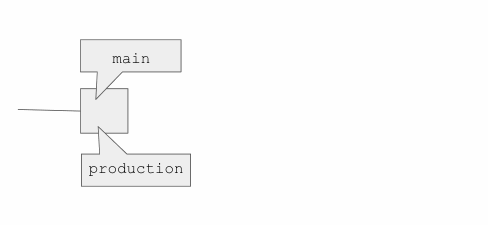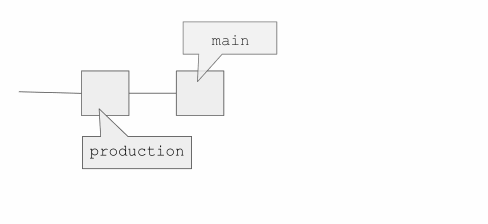Built-in deployment policies
Sections
Deployment policies are prescriptive workflows for deploying Puppet code that are built into Continuous Delivery for Puppet Enterprise (PE).
When you set up a code deployment, you select the best deployment policy for your situation, and then Continuous Delivery for PE does all the Git heavy lifting to deploy your code to the correct nodes.
Deployment policies can't be triggered on their own. You specify which policy to use when you Deploy code manually or Deploy code automatically with a pipeline. When you set up a deployment, you also specify a repository, branch, commit, environment, or other parameters that determine where to deploy your code, which version of your code to deploy, and how and where the deployment policy operates.
Deployment policy comparison
Continuous Delivery for Puppet Enterprise (PE) has four built-in deployment policies, each with a different branching workflow. The following table compares the deployment policy options to help you select the best policy for your circumstances.
| Deployment policy | Description | Use cases |
|---|---|---|
| Direct deployment policy | Deploy code to one node group. |
|
| Temporary branch policy | Create a temporary environment and then deploy code to batches of nodes. You can monitor the outcome of each batch. |
|
| Eventual consistency policy | Deploy new code and allow nodes to pick up the new code at their regular Puppet run intervals, rather than forcing the change through an immediate orchestrator job. |
|
| Feature branch deployment policy | Deploy code from a feature branch to a dedicated feature branch environment. |
Restriction: Only available for regex branch
pipelines.
|
| Custom deployment policies | Use Bolt plans to create a unique policy. | You have a special use case that isn't addressed by any of the built-in deployment policies. |
Direct deployment policy
The direct deployment policy is the most basic of the four built-in deployment policies. Use this policy when you want to deploy a specific commit to a specific environment, and then use a Puppet run to deploy the change on only that specific environment.

-
Synchronize code: Using Code Manager, Continuous Delivery for PE synchronizes your selected code change with
your PE instance by running
puppet-code deployon Puppet Server. -
Create temporary environment node group:
Continuous Delivery for PE creates a new environment node group as a
child of the node group you selected when setting up the deployment. This new
child node group inherits all the rules, configuration settings, and variables
of its parent node group. A Puppet Query Language (PQL) query
pins all nodes associated with the parent node group to the child node
group.Note: This environment node group is temporary, and it is automatically deleted after the code deployment. It is unlikely you'll ever interact directly with this environment node group.
- Run Puppet: Continuous Delivery for PE uses the orchestrator to start a Puppet run on the nodes in the new environment node group. This Puppet run applies the new code to the nodes as quickly as Puppet Server's concurrency limits allow. You can monitor the Puppet run's progress on the deployment details page in the Continuous Delivery for PE web UI.
-
Clean-up: After the Puppet run, Continuous Delivery for PE deletes the temporary environment node group
and moves the
HEADof the target branch (in your source control repository) to the commit you chose to deploy.
Direct deployment policy parameters
.cd4pe.yaml file as
part of a type: deployment step declaration.| Parameter | Type | Description | Default value |
|---|---|---|---|
max_node_failure |
Integer | The maximum number of nodes that can fail before the deployment is stopped and reported as a failure. | Empty (unlimited nodes can fail) |
noop |
Boolean | Indicates whether to perform the Puppet run in no-op mode. | false |
fail_if_no_nodes |
Boolean | Indicates whether to stop the deployment and report a failure if the selected node group does not contain any nodes. | false |
Temporary branch policy
When a deployment uses the temporary branch policy, Continuous Delivery for Puppet Enterprise (PE) creates a temporary Git branch (that contains the Puppet code you want to deploy) and a temporary environment node group (that contains the nodes you want to deploy the code to). The new code is then deployed to the nodes in the temporary environment node group in batches. This allows you to monitor the outcome of each batch and be certain that your new code works with each node before deploying the changes to the actual environment.

-
Create a temporary branch: Based on the commit you selected, Continuous Delivery for PE creates a new, temporary branch named
rolling_deployment_<ID>in your source control repository.Note: This branch is temporary, and it is automatically deleted after the code deployment. You'll probably never directly interact directly with temporary branches. -
Synchronize code: Using Code Manager, Continuous Delivery for PE synchronizes your code change with your PE instance by running
puppet-code deployon Puppet Server. -
Create a temporary environment node group:
Continuous Delivery for PE creates a new, temporary environment node
group as a child of the node group you selected when setting up the deployment.
This new child node group inherits all the rules, configuration settings, and
variables of its parent node group. A Puppet Query Language (PQL) query pins all nodes associated with the parent node group to the child node
group.Note: This environment node group is temporary, and it is automatically deleted after the code deployment. You'll probably never directly interact with temporary environment node groups.
- Run Puppet: Continuous Delivery for PE uses the PE orchestrator to run Puppet on the nodes in the new environment node group. Puppet runs on a few nodes at a time, based on the stagger settings you specified when setting up the deployment. You can monitor each Puppet run's progress on the deployment details page in the Continuous Delivery for PE web UI.
-
Clean up: After all Puppet runs end, Continuous Delivery for PE deletes the temporary environment node group,
moves the
HEADof the target branch (in your source control repository) to point to your chosen commit, and deletes the temporary Git branch that was created at the beginning of this process.
Temporary branch deployment policy parameters
.cd4pe.yaml file as part of a type:
deployment step declaration.| Parameter | Type | Description | Default value |
|---|---|---|---|
batch_delay |
Integer | How many seconds to wait between each deployment batch. | 60 |
batch_size |
Integer | How many nodes to include in each deployment batch. | 10 |
max_node_failure |
Integer | The maximum number of nodes that can fail before the deployment is stopped and reported as a failure. | Empty (unlimited nodes can fail) |
noop |
Boolean | Indicates whether to perform the Puppet runs in no-op mode. | false |
fail_if_no_nodes |
Boolean | Indicates whether to stop the deployment and report a failure if the selected node group or target environment does not contain any nodes. | true |
Eventual consistency policy
Use the eventual consistency policy to deploy new Puppet code that nodes can pick up during their next scheduled check-in, rather than immediately applying the changes with a dedicated Puppet run. With this policy, the impacted nodes pick up the new code over time and eventually all become consistent with the new code.
-
Synchronize code: Using Code Manager, Continuous Delivery for PE synchronizes your selected code change with your PE instance by running
puppet-code deployon Puppet Server. - Apply changes during scheduled Puppet runs: Rather than using the orchestrator to start a Puppet run to specifically deploy the new code, the code is distributed to nodes over time. The new code is delivered to each impacted node according to their regular check-in schedule.
Eventual consistency deployment policy parameters
There are no additional parameters associated with the eventual consistency deployment policy.
Feature branch deployment policy
The feature branch deployment policy deploys code changes you've made on a feature branch to a Puppet environment with the same name as the feature branch.
When a deployment in a regex branch pipeline uses the feature branch deployment policy, Continuous Delivery for Puppet Enterprise (PE) deploys code to the feature branch environment. Using Code Manager, Continuous Delivery for PE deploys the commit in the pipeline to a Puppet environment with the same name as the feature branch that triggered the pipeline run. If an environment with the feature branch's name doesn't already exist, Continuous Delivery for PE creates this environment during the deployment.
Feature branch deployment policy parameters
There are no additional parameters associated with the feature branch deployment policy.
